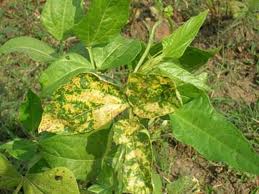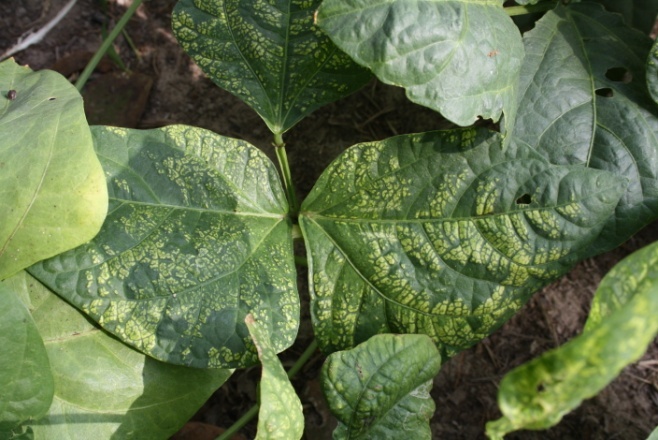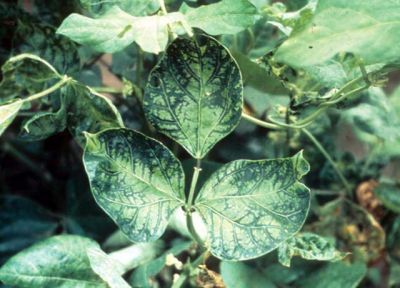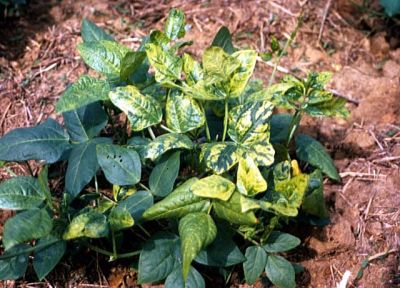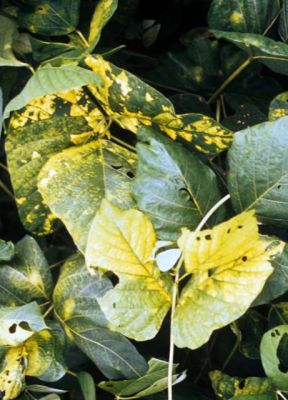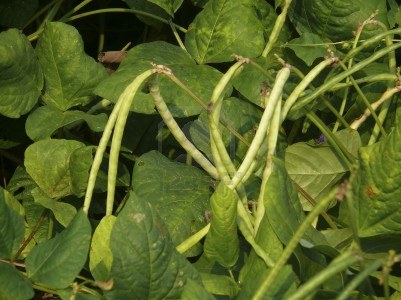
Crop: Cowpea
Scientific name : Vigna unguiculata L. Walp
Common / Local Name : Alsando

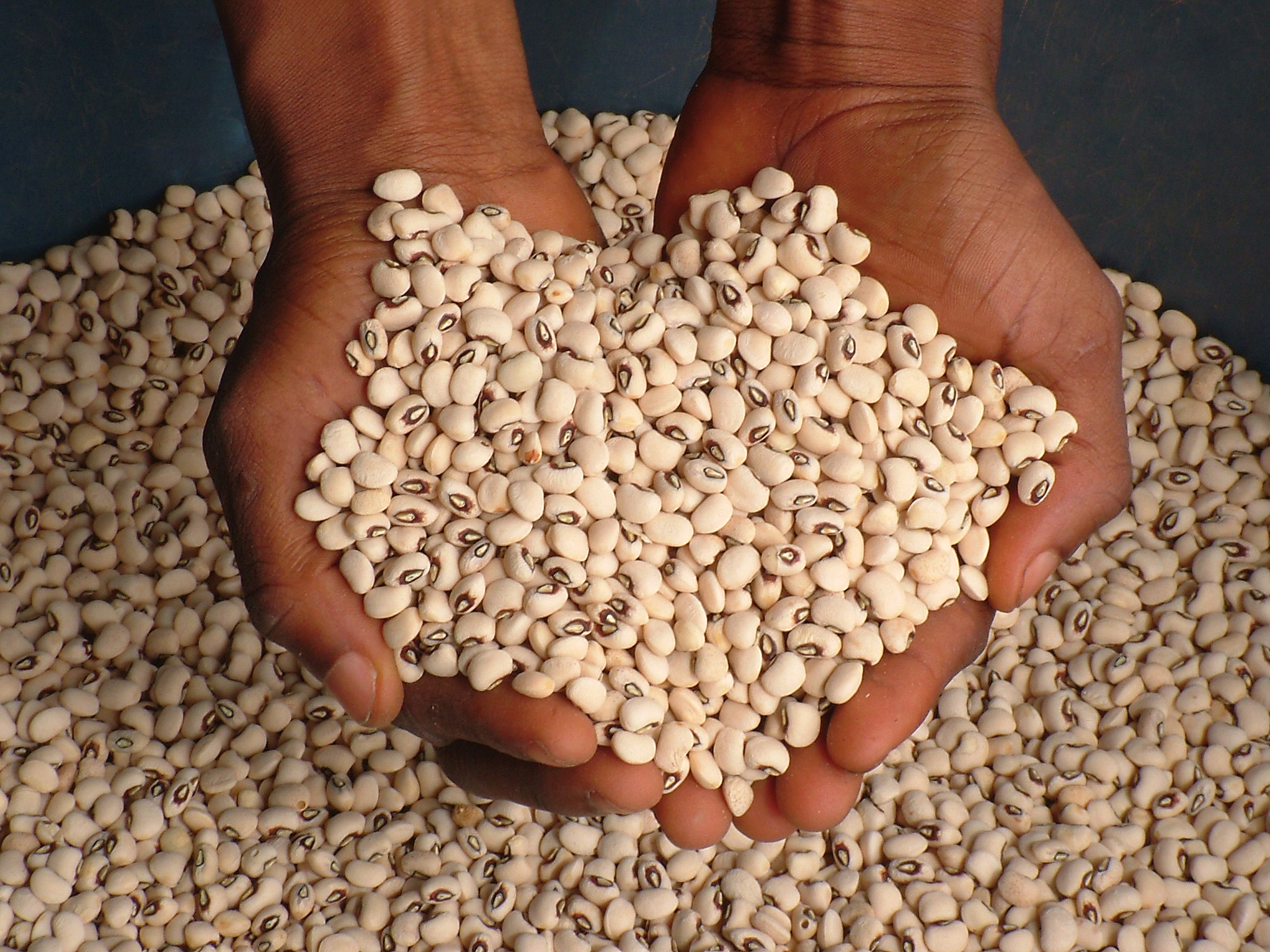
Introduction on cowpea.
Prepare the land by ploughing at right moisture situation and level the surface by planking to conserve the moisture using a country plough or stir the soil using a rotavator. Take care to uproot the weeds fully and allow them to dry out.
Ensure an optimal plant population for better yield potential. Use only local Cowpea selection having higher yield potential which is more economical. About 35-40 kg seed is required to plant one ha. Treat this seed with 375-500 g of Rhizobium before sowing specially in newly cultivated areas so as to ensure the benefit of biological nitrogen fixation. Open the planting lines at required spacing (45cm for Alsondo-1 Selection and 60 cm for Goa Nadora and Goa Cowpea-3). It is better to sow in plough-sole so as to place the seed in the moist zone at a depth of 5 cm.
One of the main reasons for the low productivity of cowpea is lack of a suitable high yielding variety of the crop. Sporadic attempts to introduce few high yielding types of small seeded cowpea were although made, yet these varieties could not become popular among the farmers owing to local preferences for bold grain types. This is because Local Cowpea (Alsondo) is a delicacy in the region owing to its unique taste and bold sized seeds. ICAR Research Complex for Goa with its research efforts in collection, cataloguing, evaluation and selection for specific traits over a period of last one decade, has identified three selections of local cowpea with specific advantages.
Alsondo-1: It is a determinate type of local cowpea selection with bold pods and high yield. It grows to a height of 55 cm with 3-4 primary branches under normal conditions. It responds well to a spacing of 45 cm to accommodate more plants per unit area. Under ideal conditions the selection produces 12-13 long pods having a length of 24-25cm with 15-16 seeds per pod. The test weight of the selection is around 20-21g/100 seeds. The harvest index of the selection is quite high (0.54). The selection has a potential seed yield of 1290 kg/ha and a haulm yield upto 3t/ha. The selection takes about 47 days to flower and matures in 90 days.
Goa Nadora (Nadora Bardez-4): It is an indeterminate type of local cowpea selection with bold pods and high yield. It grows profuse with dense foliage (upto 44 trifoliate leaves/plant) with 2-3 primary branches under ideal conditions. The selection takes 63-65 days for flowering with a total crop duration of 100 days. The selection produces pods in clusters with 6 to 10 pods/plant having a length of 18 to 22cm. Normally each pod will have 10 to 14 seeds with a test weight of 24 g for 100 seeds. The selection has a potential seed yield of 1630 kg/ha and a haulm yield of 3.31 t/ha.
Dhulape Utorda-3 (Goa Cowpea-3): It is also an indeterminate type of local cowpea selection with bold pods and high yield. It grows to height of about feet with profuse dense foliage (upto 40 trifoliate leaves/plant) with vine growth upto one metre having 4-5 primary branches under ideal conditions. The selection takes 68-70 days for flowering with total crop duration of 100-105 days. Each plant produces 14-20 smooth greenish white pods in clusters measuring 23- 25cm. Each pod will have 13 to 17 light brownish seeds having a test weight of 25 g for 100 seeds. The selection has a potential seed yield upto 2000 kg/ha and a haulm yield of 4.30 t/ha.
Apply Rock phosphate @ 250 kg / ha during sowing preferably in the planting lines to ensure better fertilizer use efficiency. Application of 25 kg N, 50 kg P2O5 and 25 kg K2O gives better response with increased yield.
The crop is grown extensively as a rice fallow crop under residual moisture situations in the region. However, late sown crop gives better response for 1-2 irrigations. Excess moisture availability especially in the early stages of the crop will not only produce more vegetative growth but also reduces yield and delays the crop.
Use of Rotary hoe in the line planted crop helps in minimization of weeds. Early weed control for first 45 days is crucial to ensure higher yield.
Each phase of cowpea attracts a number of insect pests and diseases. The major insect pests are Aphid, Aphis craccivora,Gram pod borer Helicoverpa armigera, Spotted pod borer Maruca testulalis, Leaf hopper Empoasca kerri, Pod bugs Riptortus pedestris and Whitefly Bemisia tabaci. Among these, aphid is a major economic pest of cowpea. The important diseases are root rot and damping off- Pythium, Rhizoctonia and Macrophomina, cowpea mosaic and Fusarium wilt Fusarium oxysporum.
Management of Aphids
Cowpea aphid, Aphis craccivora is a cosmopolitan species with a worldwide distribution; abundant in subtropical and tropical regions, and in the Mediterranean. It is one of the commonest aphid species found in the Goa region and causes considerable yield loss to farmers. Other aphids like Aphis gossypi and Myzus persicae also attack cowpea crop during rainy season.
Hot plants
Cowpea aphid A. craccivora is mainly found on plants in the Leguminosae. It is a major economic pest of cowpea and groundnut, particularly in the tropics and a significant pest of mungbean (Vigna radiata), pigeonpea (Cajanus cajan), chickpea (Cicer arietinum), field and green beans (Vicia spp. and Phaseolus spp.), lupins (Lupinus angustifolius), lentil (Lens esculenta) and lucerne (Medicago sativa). It is also a minor pest on a range of other leguminous crops and also some non-leguminous crops, such as cotton and citrus. Crop losses caused by A. craccivora are due to direct feeding damage and to indirect damage, chiefly via the transmission of plant viruses.
Symptoms of damage
?Both adults and nymphs feed mostly on growing tips, young foliage and pods of mature plants by sucking the sap.
?Under heavy infestation, the plant becomes chlorotic and leaves curl.
?The infested plants become stunted, leading to leaf distortion, premature defoliation and death of seedlings.
?While feeding, this aphid produces a considerable amount of honeydew upon which sooty mould grows. The black sooty mould reduces photosynthesis of plants.
?An indirect and generally more harmful effect, even of small populations, is the transmission of cowpea aphid-borne mosaic virus.

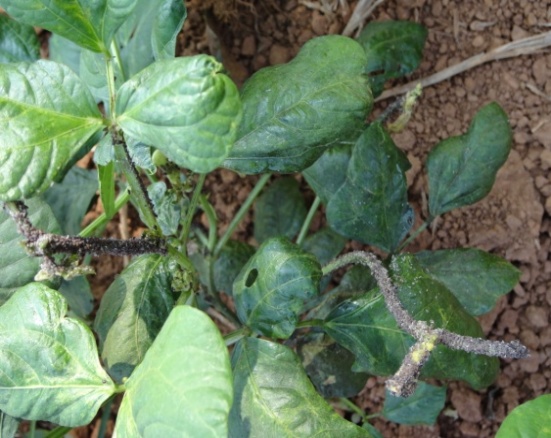
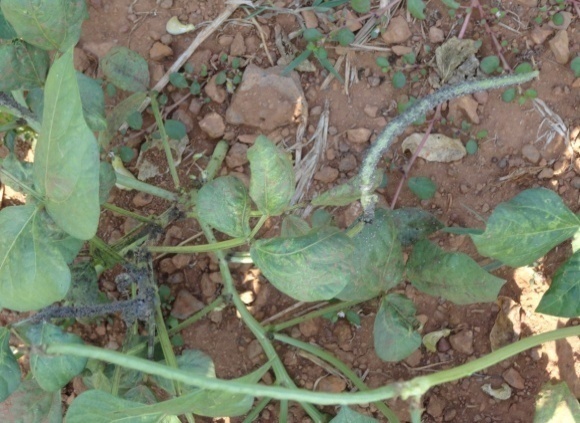
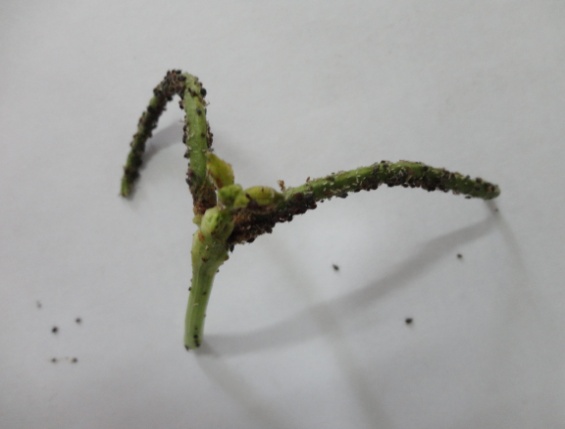
Identification and Monitoring
?The adults are black and shiny, up to 2 mm long and some are winged.
?Nymphs are covered with waxy coating that makes them grey and dull.
?Nymphs and adults colonise on young stem, leaves, flowers and pods.
Visit regularly and observe for the insect at borders in early stages.
Management
Culture control
?Grow different crops or grow crops in rotation every cropping season. This practice provides food, shelter and it increases the number of natural enemies that prey on aphids.
?Avoid using heavy doses of highly soluble nitrogen fertilizers.
?Control and kill ants.
?Clean cultivation.
Physical and mechanical control
?Spray a steady stream of water on the host plant to knock-off aphids. Once on the ground, the fallen aphids are prey to ground predators and they have difficulty returning to the plant.
?Use yellow sticky traps. Aphids are attracted to yellow color.
?Handpicking and destruction of various insect stages and the affected plant parts.
Biological control
?Parasites and predators especially Coccinellids reduce the population of aphids considerably. ?Release of Menochilus sexmaculata @ 1250/ha.
?Conserve bio agents like flower bugs (Anthocorids), lady bird beetles (Coccinellids), praying mantids, hover flies (Syrphids), green lace wing (Chrysopids), long horned grass hoppers and spiders.
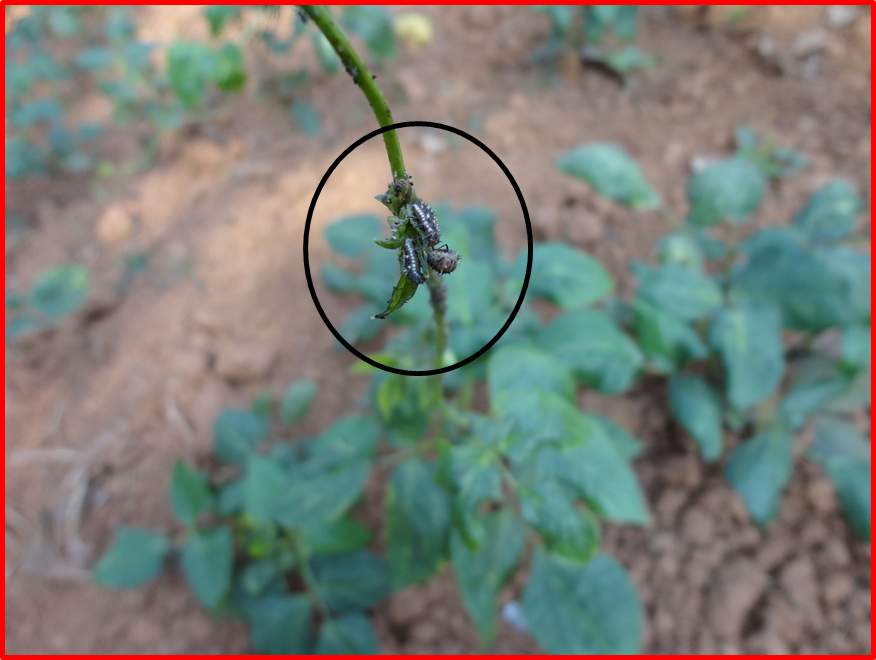 Aphids preyed
Aphids preyed
 Yellow sticky trap
Yellow sticky trap
Chemical control
?Young crop may be applied with chlorpyriphos 2 ml/litre of water or dimethoate 30 EC @ 650 ml/ha in 600 litre of water.
?If the terminal buds are infested in the young crop, spray dimethoate @ 1 lit/ ha on 30 days after sowing.
?Apply NSKE 5% (neem seed kernel extract) to control the aphids.
I. Seedling diseases
Seedling mortality
Pythium aphanidermatum, Rhizoctonia solani and many other soil fungi Pre and post emergence seedling mortality is one of the important diseases observed in cowpea field.
Symptoms
Seeds may rot before emergence from the soil and the young seedlings may die. In case of post emergence damping off, reddish brown lesions appear on collar region of hypocotyl followed by rapid death of young plants. The lesion is limited to collar regions only in case of R. solani infection. However, in case of P. aphanidermatum, the lesion moves upwards and watery lesion cause collapse of seedlings.
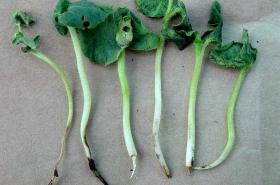 Damping off
Damping off
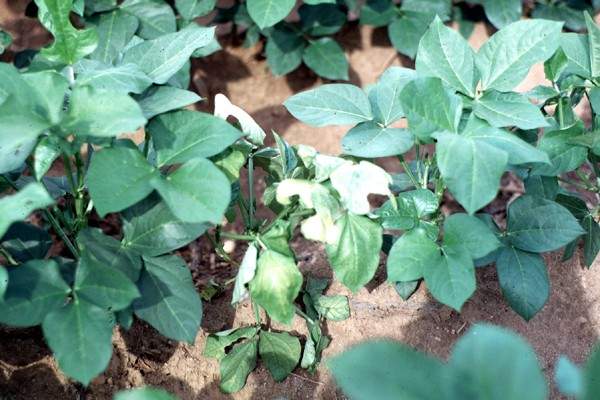
 Root rot
Root rot
Management
?Drain the field of excessive water.
?Seed treatment with Trichoderma viride @10g/kg or Pseudomonas fluorescens @ 10g/ kg of seed or Carbendazim or Thiram 2g/kg of seed.
?Spot drenching with Carbendazim 1g/lit or P. fluorescens / T. viride 2.5 kg/ha with 50 kg FYM.
?Use pathogen free certified seeds
II. Foliar diseases
Cercospora leaf spot: Cercospora canescens
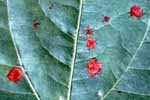

Symptoms of damage
Rough, circular, cherry red to dark red spots on the upper leaf surface. The centre becomes silvery grey when spores are produced. In severe cases, defoliation occurs.
Management
Destroy diseased debris. Use pathogen free seeds from healthy plants. Seed treatment with carbendazim or thirum @2g/kg of seeds. Spray mancozeb (0.2%) or carbendazim (0.2%) at fortnight interval
Septoria leaf spot: Septoria vignae
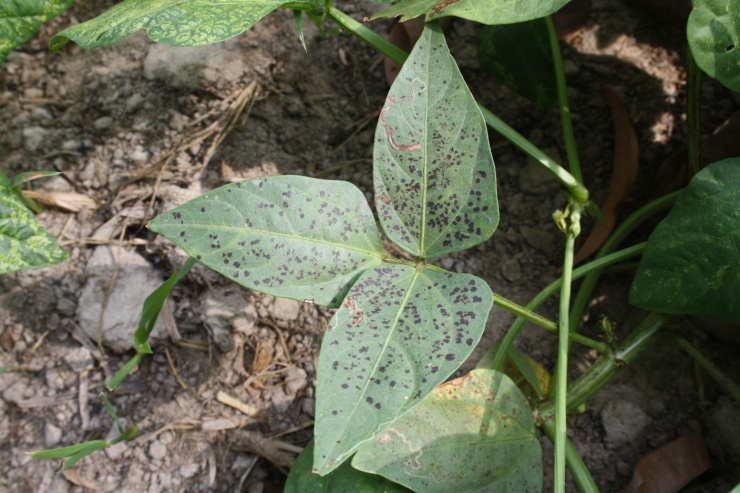
Symptoms of damage
Small, pinhead size, reddish brown, circular, water soaked scattered spots on both the surface of leaves. The spots rapidly enlarge to irregular lesions. Spots later turn light brown with dark brown margins.
Management
Spray mancozeb (0.2%) or carbendazim (0.2%) at fortnight interval.
Brown rust: Uromyces appendiculatus
Symptoms of damage
Minute, almost white, slightly raised pustules on the leaves. Plants with heavy rust infection appear to have brown tinge. Stunting and light green plants are observed.
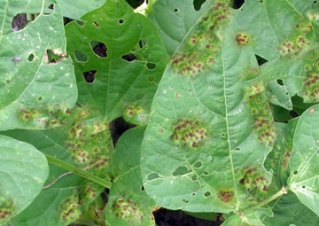

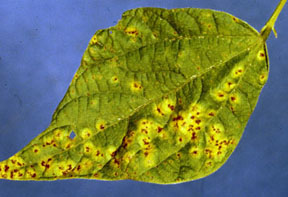
Management
Spray mancozeb (0.2%) or oxycarboxin (0.1%) at fortnight interval
III. Anthracnose: Colletotrichum lindemuthianum
Symptoms of damage
Brown sunken lesions with dark red margins develop on the stems. Many lesions rapidly merge to girdle stems, branches, peduncles and petiole. Elongated lesions appear on the leaf veins and tannish red spots with yellow halo on the leaf surface. Lesions similar to those found on the stem also occur on pods. Severely affected pods are curled and do not contain normal size seeds.
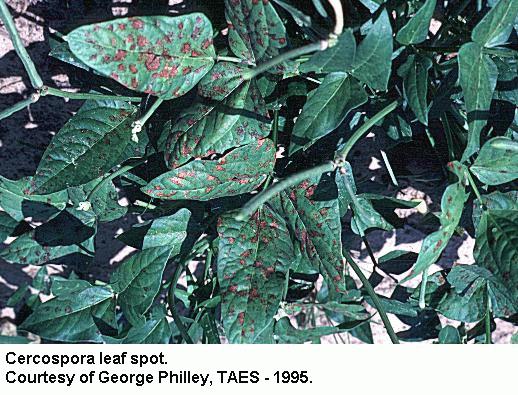
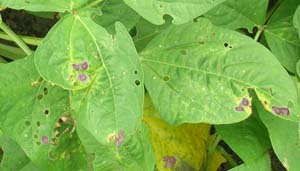
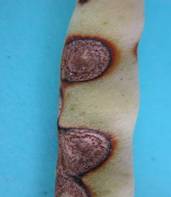
Management
?Crop rotation with non-host crops for 2-3 years.
?Seed treatment with carbendazim or thirum @2g/kg of seeds.
?Spraying of mancozeb (0.2%) or carbendazim (0.2%) at fortnight interval.
IV. Charcoal rot/ root rot: Macrophomina phaseolina
Symptoms of damage
The seedlings remain stunted and some of them develop rot in the hypocotyls region and extend downwards. Roots also exhibit rotting and seedlings get dried. In mature cowpea plants, grayish black sunken lesions appear on the lower stem and roots accumulate small black sclerotia. Sometimes stem girdle which may break longitudinally.
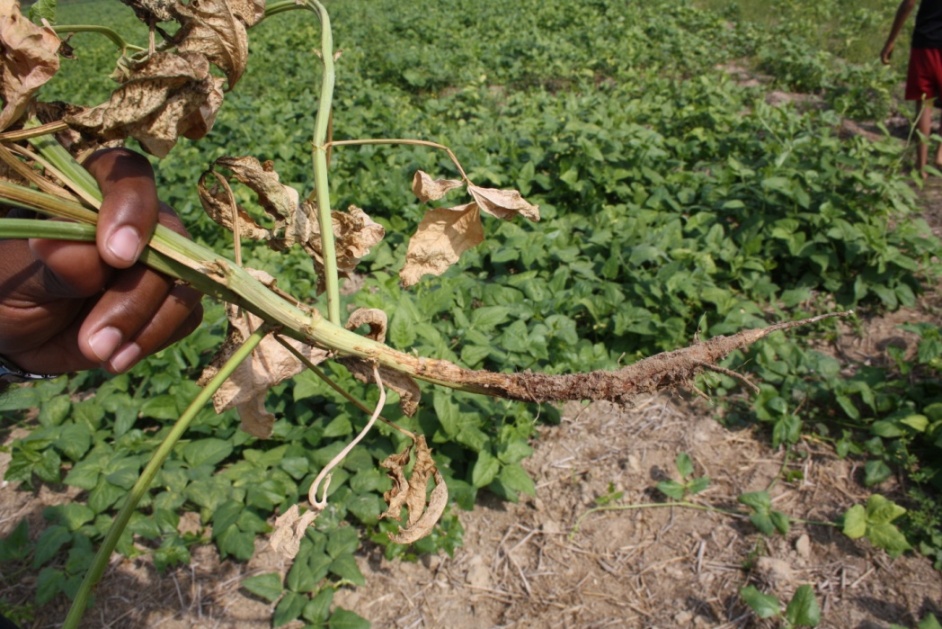

Management
?Crop rotation with non-host crops for 2-3 years
?Seed treatment with carbendazim or thirum @2g/kg of seeds.
?Seed treatment with Trichoderma or other biocontrol agent @10g/ kg of seeds and soil application of biocontrol agents along with organic manure.
V. Viral diseases- Cowpea mosaic diseases
Symptoms of damage
Several viruses cause disease in cowpea. These viruses produce a mosaic pattern (intermixing of green and yellow patches) on leaves. They may be found singularly or in combination with others. They cause irregular light and dark green mosaic patterns on the leaves. Some viruses cause thickened, malformed and distorted leaves. The mosaic patterns are best observed on the younger foliage. Plants may be stunted and fail to produce normal pods. If the disease attacks plants at the early growth stage, no pods should be expected.
The most common virus disease on cowpeas is cowpea aphid-borne mosaic potyvirus. It is transmitted by aphids. List of common viruses infecting cowpea are given below.Virus |
Characteristic symptoms |
Vector |
Cowpea mosaic virus |
Mosaic |
|
|
||
Virus |
Characteristic symptoms |
Vector |
Cowpea severe mosaic virus |
Mosaic |
Beetles |
|
||
Virus |
Characteristic symptoms |
Vector |
Cowpea yellow mosaic virus |
Mosaic, leaf distortion, blistering, dwarfing and death of plants |
Beetles |
|
||
Virus |
Characteristic symptoms |
Vector |
Cowpea aphid borne mosaic virus |
Mosaic, mottling, green vein banding |
Aphids |
|
||
Virus |
Characteristic symptoms |
Vector |
Cowpea golden mosaic |
Chlorosis, leaf distortion, blistering |
whitefly |
|
||

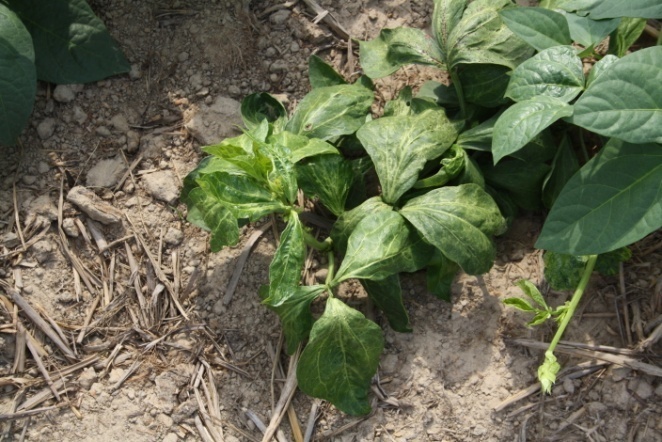
Management
?Plant resistant varieties wherever available.
?Use disease- free healthy seeds.
?Crop rotation with non-legumes for 4-5 seasons.
?Remove the infected plants at the first instance, weeds and alternate hosts.
?Management of vectors through insecticide spray to prevent secondary infection.
?Spray any one of the systemic insecticide like Chlorpyriphos @0.1% to control the vector.
?Spray Metasystox @ 1 litre/hectare dissolved in 1000 litres of water to check the whitefly.
The crop will be ready for harvest in about 100?05 days under residual moisture situation. Pluck the pods on maturity once they turn brown, dry the pods immediately and thresh the produce. Dry the seeds to reduce the moisture level below 10?2 % and add finely grounded Tirphal / boric acid powder @ 2 g / kg of seeds to reduce the infestation by stored grain pests.
Properly dried local cowpea is relatively more tolerant to the infestation of pulse beetle than small seeded cowpea varieties like C-152. Use of insecticide carbaryl @2.5 g/kg is more effective in inhibiting the pulse beetle attack without affecting the germination of the seeds.
Input availability |
Address/Contact details |
| Seeds | ICAR-CCARI, Old Goa, Directorate of Agriculture- Tonca Panaji-Goa, Goa Bhagayatdar Society,Ponda-Goa. |
Fertilizers |
For detailed list kindly click here |
Pesticides |
For detailed list kindly click here |
|

